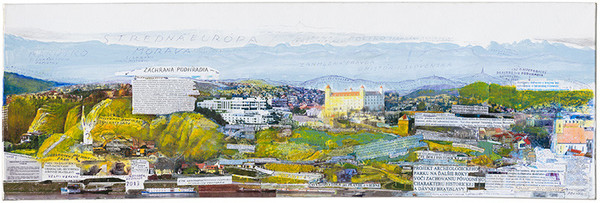As part of the exhibition cycle In the Interpretation, we present another contribution by Petr Bartoš (1938) in collaboration with Ľudmila Rampáková on the topic of history and the current transformation of the Bratislava castle grounds. The ancient territory of the city, which forms its panorama and hides many geological and cultural treasures, became the epicentre of the author's work several years ago. He examines it, studies it, discusses it with experts, observes and conceptualizes its gradual devastation in the name of new urban development plans.
It conceptualizes the entire construction process, including drills and excavators eating away at the castle hill, destroying traces of the past in favour of a future vision in the form of elegant architecture on lucrative land. However, the depiction of this area in drawing, painting and collage has long been the centre of Bartoš's interest and his own map, as was the Bratislava Zoo in the 1970s and 1980s and the Central European region in the 1990s.
The late work of our unique artist reflects his need to express himself through artistic means - publicly, boldly and in an original way. Bartoš comments on the current physical condition of Bratislava, the mentality and education of the citizens of Slovakia, their relationship to the issue of the castle, also touching the topic of protection of cultural monuments and the environment of the "home country" in general.
Lucia G. Stach
The view of Bratislava Castle and Castle Hill is intimately known to the city residents and visitors alike. For a very long time, the view has been a source of pain, recently exacerbated by the sight of heavy machinery biting off large chunks of rock in pursuit of radical reconstruction and transformation. Peter Bartoš, one of the key figures of Slovak neo-avantgarde's key figures became the first visual artist since the 1960s to address - as he calls it - "relationships in nature" and later issues of ecology, the devastation of natural and cultural monuments and the environment in which we live. Bartoš has been dealing with the concept of transformation of the historical Podhradie district for a long time, and this work forms an integral part of his current oeuvre. He first encountered the Castle Hill problem through his son Ilja - as a student in the 1970s, he photographed the demolition of the Vydrica neighbourhood - part of the historic district of Zuckermandel. He included this "topic" in his (unofficial) exhibition Bleskovky a plagiáty (lit. Flash News and Plagiarism) presented at the Club of Visual Artists and Architects in 1978. Through his presentation, he commented on and criticised the numerous architectural interventions happening across Bratislava.
A key aspect of Bartoš's work focused on active and practical ecological landscaping. In numerous projects dealing with the Bratislava Podhradie, he used his previous experience designing an ecological Forest-Meadow Park above Lamač (concept 1972, project 1973, realisation and planting 1979). He is also known as a designer and composer of individual parts of the Bratislava Zoo, where he was employed (inner-city ZOO landscape, hills for breeding of Hucul horses, among others). Ľudmila Rampáková (1945), a former television author and dramaturge, intensively collaborated on Bartoš's vision for Bratislava Podhradie. She helped drawing attention to the archaeological sites (a project of archeo-park), rescued the southernmost edge of Castle Hill cliffs with the mahabel cherry tree and incorporated them into the existing environment. She also collaborated with Viliam Figusch from the office of the Council of Europe, which nominated her for the international exhibition Eco-Photography 2007, where she also presented her defence of the Bratislava Podhradie.
In the case of the Bratislava Podhradie, Peter Bartoš wishes to find an acceptable and sustainable compromise, one that he has been trying to offer to the competent at the Bratislava City Hall for the past twenty years. Trying to preserve the overall genius loci of the area, he designed various geo-ecological, landscaping and park interventions for Castle Hill and the area below him. Stubbornly defending his idea, he perceives this area as a valuable part of the common European cultural heritage. He has always seen things in the context of their relationships, which he tried to visualise, draw and describe in his paintings-projects. The initial flurry of information turns into an original visual system, a pictorial "hypertext", where everything connects to everything - a system one can not only read but one can also look at.
Katarína Bajcurová
The exhibition cycle In the Shop Display enters the public space through the window of Café Berlinka on the ground floor of the Esterházy Palace, presenting works of visual art responding to the issues of contemporary life. In this exhibition format, we have revived collaboration between Peter Bartoš and Július Koller, who exhibited their works in a storefront of a stocking repair shop in Klobučnícka Street in Bratislava under the title Interpretation (Anti-gallery).
